Writer Joseph J. Airdo // Photography by Brian Passey
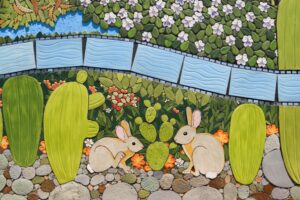


Five decades ago, New York City-based artist Louise Nevelson unveiled Scottsdale’s first large-scale, public artwork — a sculpture, formally titled “Atmosphere and Environments XIII,” but more affectionately called “Windows to the West.”
The piece, installed at what was then the new Scottsdale Civic Center Mall, would start a movement that has since led to the commissioning of more than 150 permanent and temporary public artworks throughout the city.
On Thursday, Oct. 26, the city of Scottsdale and Scottsdale Public Art, a department of the nonprofit organization Scottsdale Arts, will host an event commemorating the 50th anniversary of Nevelson’s sculpture, while simultaneously dedicating the newest work in the city’s permanent art collection.
“This event will honor Scottsdale’s 50-year legacy of integrating public art into the building of our city,” says Kati Ballares, the director of Scottsdale Public Art. “We know our residents and visitors appreciate how the city is so intentionally designed, but few people actually know that Scottsdale Public Art has played an ever-increasing role in this process since the early 1970s.
“The opening of the renovated Scottsdale Civic Center and the completion of our newest public artwork is a great opportunity to celebrate and tell this story.”
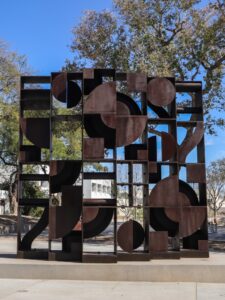


‘Windows to the West’
On June 5, 1970, the National Endowment for the Arts awarded the city of Scottsdale a $20,000 matching grant to commission a monumental work of art by “an outstanding American sculptor.” In February 1972, after raising $20,000 in private contributions, the Scottsdale Fine Arts Commission selected esteemed female sculptor Nevelson to create her first large-scale work in the Southwest.
“It was a bold move for the early 1970s, when nearly all public art in the country was created by men, and the other considered American sculptors for the project were men,” says Wendy Raisanen, curator of collections and exhibitions for Scottsdale Public Art. “Nevelson was a real trailblazer in her art career and life. As a young artist at Scottsdale High School, I saw her as a role model and icon.”
Dedicated Nov. 11, 1973, “Windows to the West” sought to capture shadow and light while incorporating a myriad of abstract forms. The contemporary nature of the artwork initially drew criticism from some vocal Scottsdale residents, who preferred Western realism instead.
However, by the late 1990s, it was named the most popular sculpture in the city’s collection.
Nevelson’s work has since been relocated to an area just north of Scottsdale Center for the Performing Arts, facing Scottsdale Civic Center’s West Paseo — a corridor stretching westward to connect with the shops along Main Street in Old Town Scottsdale.
Over the last 50 years, countless other public artworks have been added to the city’s collection — such as Bob Parks’ “Bronze Horse Fountain,” Curtis Pittman’s “Diamond Bloom,” Donald Lipski’s “The Doors,” Ed Mell’s “Jack Knife” and George-Ann Tognoni’s “The Yearlings.”
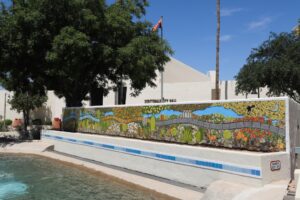


‘The Desert’s Garden’
A juxtaposition five decades in the making, Scottsdale Public Art this year unveiled the city’s newest large-scale, public artwork — “The Desert’s Garden” — across the lawn from “Windows to the West.”
Created by Arizona-based artist Tammi Lynch-Forrest, the 40-foot mosaic wall combines thousands of hand-crafted tiles to depict flora and fauna of Scottsdale’s desert landscape. The canal, trail and sidewalk represent the flow of time, while the beauty of desert plants and charming animals, native or introduced to the area, are shown throughout.
Lynch-Forrest says that the mosaic reflects her fascination with the intricately woven tapestry of life that is the ecosystem of the Sonoran Desert.
“In this work, I attempt to capture [the desert’s] amazing interconnectivity of diverse and unique species,” she explains. “It is also my way of showing my admiration for the ways that nature provides abundance and nourishment, even in the most challenging of environments.
“In our desert, what might first appear to be a barren landscape, actually has life teeming in its every crack and crevice. The desert’s citizens are hidden away in its rocks and plants, and even under its dry surface. It is at its hottest and driest that the desert sleeps. And most people think of it that way. But we know better.
“After it rains, the desert awakens to become a wealth of new life and color. Exploding with wildflower blooms, its trees and bushes are laden with flowers, fruits and seeds. When the desert is blooming, the dry and harsh landscape becomes a desert garden.”
Lynch-Forrest adds that she believes each flower and creature — down to the tiniest insect — is its own work of art.
“I am in awe of the artistry of nature,” Lynch-Forrest says. “She is the ultimate artist, and I only attempt to capture and share the beauty that she has already created.”
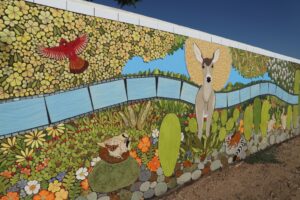


Identity & Legacy
Raisanen says that Scottsdale is fully aware of the value that public art brings to the city’s visitors and residents, which is why in 1985 it established Scottsdale Public Art to enhance the quality of life in its communities by incorporating art and design projects throughout.
“Art is something that allows us to see our world in a new way,” Raisanen adds. “Artists provide us a window into another way to see where we live, how we live and what we value. I think that these viewpoints from all of these different artists help us better understand our world.”
Lynch-Forrest agrees.
“I feel that public art is important to the vitality of a community,” she explains. “I worked on-site for several months installing ‘The Desert’s Garden’ and had the unique opportunity to daily watch and listen to people enjoying the public art around me. I saw families interacting with the pieces, and I also saw that many visitors came specifically to view a certain piece, then went on to enjoy what else the area had to offer.
“Public art brought the community and visitors alike to where the museums, shops and restaurants were. I could see that locals felt a sense of pride in their city’s public art; and for the visitors, it became a part of their photo ops as they posed with it, becoming a part of their memories of the city. Public art becomes a part of a city’s identity and a way to share its legacy.”
50th Anniversary Celebration of Scottsdale Public Art
Thursday, Oct. 26 // 4–6 p.m. // Scottsdale Civic Center // 3939 N. Drinkwater Blvd., Scottsdale // Free // scottsdalepublicart.org

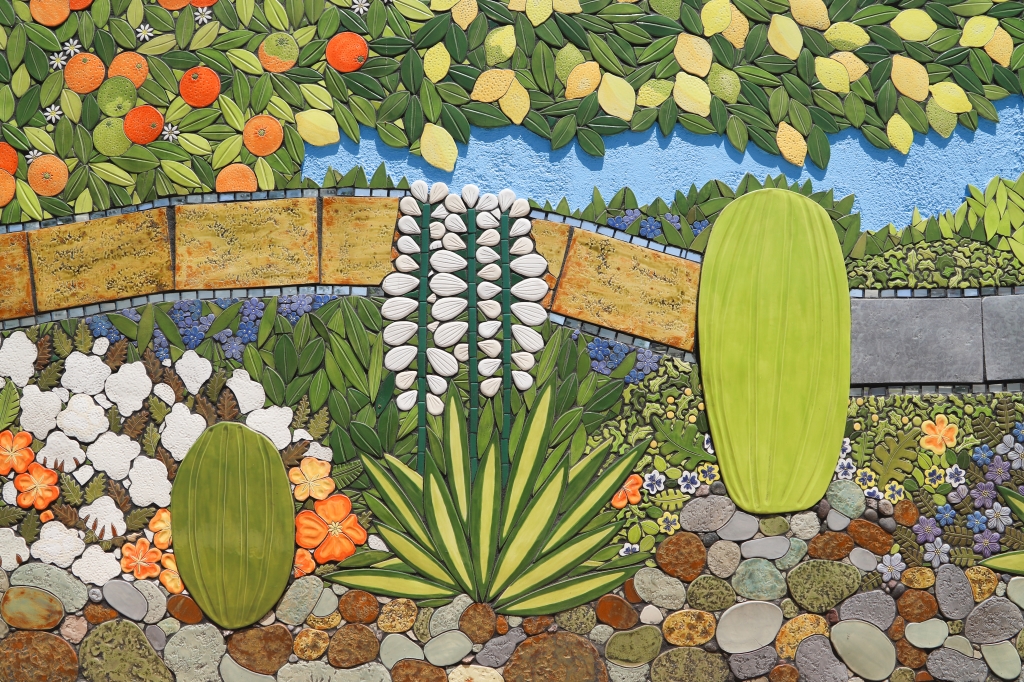

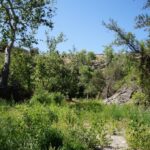
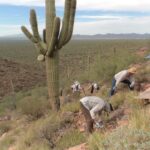
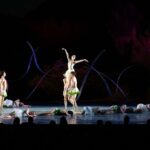

Comments by Admin